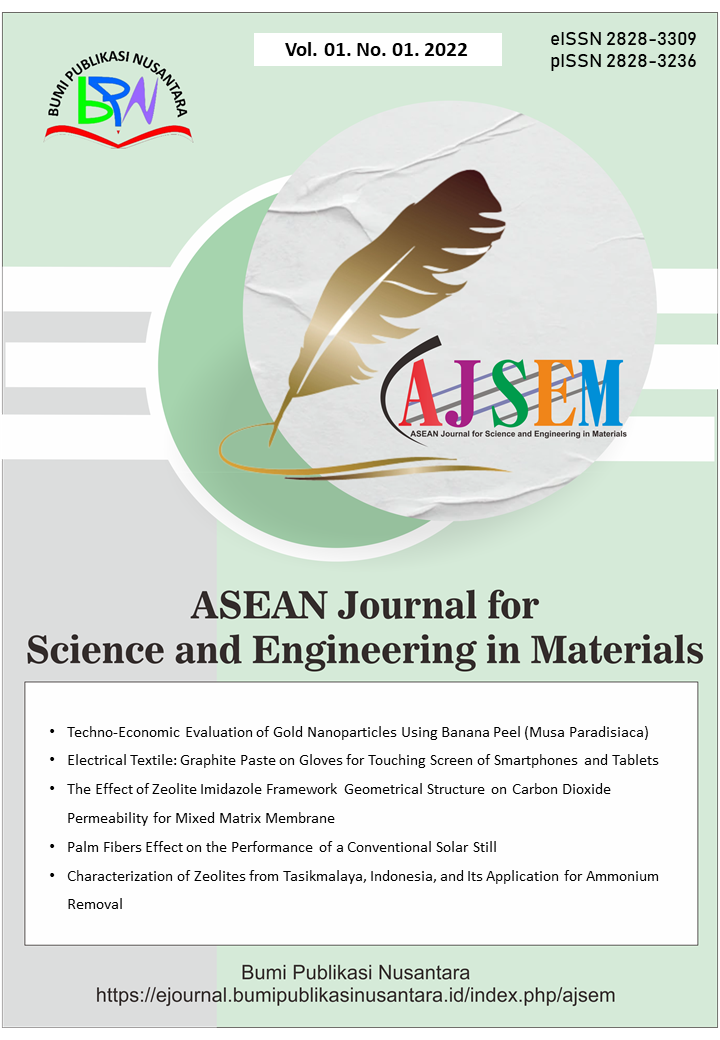Experimental Analysis of rGO-V₂O₅ Nanocomposites for Sus-tainable Water Remediation Completed with Bibliometric Analysis Toward Achieving Sustainable Development Goals (SDGs)
 ), Haneen Lateef Khaleel(2), Ammar W. Saeed(3), M. N. Mohammed(4), Qusay Al-Obaidi(5), Mukhtar Ali Hussein(6), Wassef Abbood Mhmood(7), Rashed T. Rasheed(8), Oday I. Abdullah(9),
), Haneen Lateef Khaleel(2), Ammar W. Saeed(3), M. N. Mohammed(4), Qusay Al-Obaidi(5), Mukhtar Ali Hussein(6), Wassef Abbood Mhmood(7), Rashed T. Rasheed(8), Oday I. Abdullah(9),
(1) University of Technology
(2) University of Technology
(3) Alkarkh University of Science
(4) Gulf University
(5) University of Technology
(6) University of Technology
(7) University of Technology
(8) University of Technology
(9) Al-Naji University; University of Baghdad; Al-Farabi Kazakh National University
 Corresponding Author
Corresponding Author
Abstract
Keywords
References
Abdul-Zahra, Z. J., and Rasheed, R. T. (2023). Preparation, characterization, and ninhydrin removal by Al₂O₃ and V₂O₅ nanoparticles. Journal of Medicinal Chemistry and Sciences, 6(2), 376–391.
Aldabagh, I. S., Saad, D. N., and Ahmed, E. I. (2024). Removal of methylene blue from aqueous solution by green synthesized silicon dioxide nanoparticles using sunflower husk. Chemical Engineering Journal Advances, 18, 100608.
Chaukura, N., Murimba, E. C., and Gwenzi, W. (2017). Synthesis, characterisation and methyl orange adsorption capacity of ferric oxide–biochar nanocomposites derived from pulp and paper sludge. Applied Water Science, 7(5), 2175–2186.
Chu, Q., Hoong, K., Hashim, M. A., Bashiri, H., Debord, J., Harel, M., and Bollinger, J.-C. (2023). The Flory–Huggins isotherm and water contaminant adsorption: Debunking some modeling fallacies. Industrial and Engineering Chemistry Research, 62(2), 1121–1131.
Deletic, A., and Wang, H. (2019). Water pollution control for sustainable development. Engineering, 5(5), 839–840.
Do, P. M. T., Phan, T. T. T., Nguyen, C. H., Downes, N. K., and Nguyen, L. X. (2023). Removal of anions PO₄³⁻ and methyl orange using Fe-modified biochar derived from rice straw. Iranian Journal of Chemistry and Chemical Engineering, 42(3), 821-834.
Ezzatfar, R., Dehghan, G., Amini, M., and Khataee, A. (2022). Synthesis of peroxidase-like V₂O₅ nanoparticles for dye removal from aqueous solutions. Topics in Catalysis, 65(5), 694–702.
Fathi, A., Asgari, E., Danafar, H., Salehabadi, H., and Fazli, M. M. (2024). A comprehensive study on methylene blue removal via polymer and protein nanoparticle adsorbents. Scientific Reports, 14(1), 29434.
Gong, R., Ye, J., Dai, W., Yan, X., Hu, J., Hu, X., Li, S., and Huang, H. (2013). Adsorptive removal of methyl orange and methylene blue from aqueous solution with finger-citron-residue-based activated carbon. Industrial and Engineering Chemistry Research, 52(39), 14297-14303.
Hien, V. X., Dong, V. T., Vuong, D. D., and Chien, N. D. (2021). From microurchins to V₂O₅ nanowalls: Improved synthesis through vanadium powder and fast, selective adsorption of methylene blue. Langmuir, 38(1), 264–274.
Homaeigohar, S. (2020). The nanosized dye adsorbents for water treatment. Nanomaterials, 10(2), 1–42.
Iqbal, M. Z., Pal, P., Shoaib, M., and Abdala, A. A. (2017). Efficient removal of different basic dyes using graphene. Desalination and Water Treatment, 68, 226–235.
Jaseela, P. K., Garvasis, J., and Joseph, A. (2019). Selective adsorption of methylene blue (MB) dye from aqueous mixture of MB and methyl orange (MO) using mesoporous titania (TiO₂)–poly(vinyl alcohol) nanocomposite. Journal of Molecular Liquids, 286, 110908.
Jehad, A. M., Rasheed, R. T., Mansoor, H. S., Mohammed, M. N., Abdullah, T. A., Mansoor, A. S., Abdul-Zahra, Z. J., Hussein, M. A., Kułacz, K., and Abdullah, O. I. (2024). Preparation and characterization of vanadium pentoxide and nickel oxide nanoparticles and their use in removing tetracycline from water. Topics in Catalysis, 68(11), 1–15.
Juzsakova, T., Salman, A. D., Abdullah, T. A., Rasheed, R. T., Zsirka, B., Al-Shaikhly, R. R., Sluser, B., and Cretescu, I. (2023). Removal of methylene blue from aqueous solution by mixture of reused silica gel desiccant and natural sand or eggshell waste. Materials, 16(4), 1618.
Khan, I., Saeed, K., Zekker, I., Zhang, B., Hendi, A. H., Ahmad, A., Ahmad, S., Zada, N., Ahmad, H., Shah, L. A., Shah, T., and Khan, I. (2022). Review on methylene blue: its properties, uses, toxicity and photodegradation. Water, 14(2), 242.
Kolya, H., and Kang, C.-W. (2024). Toxicity of metal oxides, dyes, and dissolved organic matter in water: Implications for the environment and human health. Toxics, 12(2), 111.
Lv, S. W., Liu, J. M., Ma, H., Wang, Z. H., Li, C. Y., Zhao, N., and Wang, S. (2019). Simultaneous adsorption of methyl orange and methylene blue from aqueous solution using amino functionalized Zr-based MOFs. Microporous and Mesoporous Materials, 282, 179-187.
Mahdy, S. A., and Al-Naseri, H. (2024). Effect of magnesium oxide nanoparticles (MgO) on wastewater treatment and electric current generation using microbial fuel cell technology. Tikrit Journal of Engineering Sciences, 31(2), 219–228.
Maryanti, R., Rahayu, N. I., Muktiarni, M., Al Husaeni, D. F., Hufad, A., Sunardi, S., and Nandiyanto, A. B. D. (2022). Sustainable development goals (SDGs) in science education: Definition, literature review, and bibliometric analysis. Journal of Engineering Science and Technology, 17(6), 161-181.
Mashhour, D. M., Ibrahim, S. M., Al-Hossainy, A. F., and Abd El-Aal, M. (2024). Glycogen-assisted biosynthesis of MnO₂ for adsorptive elimination of methylene blue from water. Journal of Molecular Structure, 1313, 138665.
Mubarokah, S. L., Anwar, S., Nisa, K., Miftah, H., Hastuti, A., and Nandiyanto, A. B. D. (2024). Bibliometrics study on agro-economy of biochar. Journal of Engineering Science and Technology, 19, 142-152.
Nandiyanto, A. B. D., Kurniawan, T., Bilad, M. R., and Farobie, O. (2025). Harnessing biomass for Sustainable Development Goals (SDGs): Definition, bibliometric, application, opportunities, and challenges. Journal of Engineering Science and Technology, 20(4), 1047-1068.
Nguyen, C. H., Fu, C.-C., and Juang, R.-S. (2018). Degradation of methylene blue and methyl orange by palladium-doped TiO₂ photocatalysis for water reuse: Efficiency and degradation pathways. Journal of Cleaner Production, 202, 413–427.
Nuraeni, A., Taba, P., Zakir, M., and Lakolo, L. (2023). Synthesis and characterization of mesoporous silica MCM-48 as dye adsorbent of methyl orange. AIP Conference Proceedings, 2580(1), 050028.
Obayomi, K. S., Lau, S. Y., Zahir, A., Meunier, L., Zhang, J., Dada, A. O., and Rahman, M. M. (2023). Removing methylene blue from water: A study of sorption effectiveness onto nanoparticles-doped activated carbon. Chemosphere, 313, 137533.
Ramutshatsha-Makhwedzha, D., Mavhungu, A., Moropeng, M. L., and Mbaya, R. (2022). Activated carbon derived from waste orange and lemon peels for the adsorption of methyl orange and methylene blue dyes from wastewater. Heliyon, 8(8), e09930.
Rasheed, R. T., Mansoor, H. S., Abdullah, T. A., Juzsakova, T., Al-Jammal, N., Salman, A. D., Al-Shaikhly, R. R., Le, P. C., Domokos, E., and Abdulla, T. A. (2021). Synthesis, characterization of V₂O₅ nanoparticles and determination of catalase mimetic activity by new colorimetric method. Journal of Thermal Analysis and Calorimetry, 145, 297–307.
Shankar, S., Kumar, Y., Sharma, N., Chandra, R., and Kumar, S. (2024). Disposable zirconium trisulfide–reduced graphene oxide modified conducting thread-based electrochemical biosensor for lung cancer diagnosis. Bioelectrochemistry, 160, 108801.
Sharma, P., Hussain, N., Borah, D. J., and Das, M. R. (2013). Kinetics and adsorption behavior of the methyl blue at the graphene oxide/reduced graphene oxide nanosheet–water interface: A comparative study. Journal of Chemical and Engineering Data, 58(12), 3477–3488.
Shi, Y., Song, G., Li, A., Wang, J., Wang, H., Sun, Y., and Ding, G. (2022). Graphene oxide-chitosan composite aerogel for adsorption of methyl orange and methylene blue: Effect of pH in single and binary systems. Colloids and Surfaces A: Physicochemical and Engineering Aspects, 641, 128595.
Solehuddin, M., Nandiyanto, A. B. D., Muktiarni, M., Rahayu, N. I., Al Husaeni, D. N., Ragadhita, R., and Fiandini, M. (2025). Engineering research and scientific contributions at Universitas Pendidikan Indonesia: Trends, challenges, and future directions. Journal of Engineering Science and Technology, 20(3), 816-836.
Taquieteu, I. K., Dzoujo, H. T., Shikuku, V. O., Banenzoué, C., and Joh Dina, D. D. (2023). Fixed-bed adsorption of an azo dye (methyl orange) onto chemically and thermally regenerated activated carbons. Journal of Chemistry, 2023(1), 6677710.
Xie, S., Yang, Y., Gai, W. Z., and Deng, Z. Y. (2021). Oxide modified aluminum for removal of methyl orange and methyl blue in aqueous solution. RSC Advances, 11(2), 867–875.
Article Metrics
Abstract View : 17 times
: 17 times Download : 9 times
Download : 9 times
Refbacks
- There are currently no refbacks.
Copyright (c) 2025 Bumi Publikasi Nusantara

This work is licensed under a Creative Commons Attribution-ShareAlike 4.0 International License.









